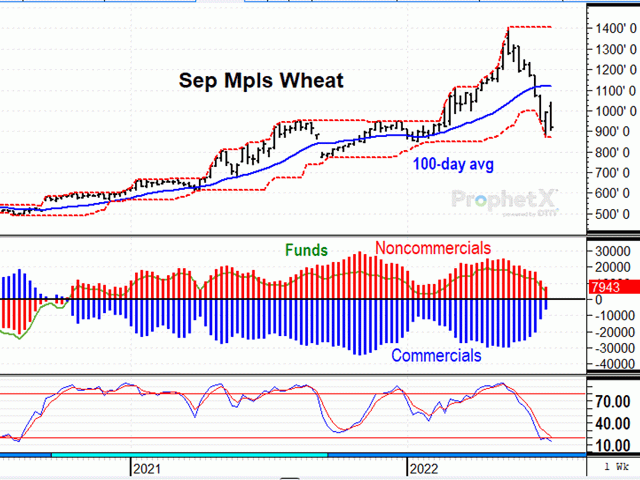Todd's Take
USDA's WASDE Report Reveals Bullish Potential in Wheat
In less than two months the price of September Minneapolis wheat has fallen 35% -- roughly from $14 to $9 a bushel. That dramatic of a drop has not been seen since April 2008, the last time September prices tried to trade above $14.00. In early 2008, as many will remember, the economy was about to embark on a financial meltdown, but the problems had not yet surfaced. The U.S. Dollar Index could not be blamed for wheat's sell-off in early 2008 as it was trading near its lowest prices on record.
In the sharp sell-off of 2008, we also couldn't blame a change in USDA's estimates for spring wheat. In the February World Agricultural Supply and Demand Estimates (WASDE) report, before the sharp decline, USDA estimated 73 million bushels (mb) of ending hard red spring (HRS) wheat stocks in 2007-08 and 530 mb of demand. In the May WASDE report, after the big drop, USDA estimated 64 mb of HRS wheat stocks and 544 mb of demand -- an even tighter supply situation.
The one important change we can point to is in late February 2008, when September Minneapolis wheat was near its peak of $14.02 1/4. USDA was estimating 70.59 million metric tons (mmt) or 2.59 billion bushels (bb) of world ending wheat stocks, excluding China. As traders looked forward to the new season of 2008-09, May's WASDE report estimated 84 mmt or 3.09 bb of new world ending wheat stocks without China, a more comfortable level of supplies.
USDA would later revise both estimates and now, looking back, USDA records show ending world wheat stocks apart from China at 89.17 mmt (3.28 bb) in 2007-08 and 123.57 mmt (4.54 bb) in 2008-09. In other words, the sharp sell-off in September Minneapolis wheat prices was the result of transitioning from a crop year with relatively tight wheat supplies to a new year that found supplies more abundant. In hindsight, the drop in prices was fundamentally understandable, as long as we also concede the high level of emotion that accompanied the high prices.
For September Minneapolis wheat, this year's sudden fall from grace is more complicated. First, we have to acknowledge the fear premium injected into prices when Russia invaded Ukraine on Feb. 24. September Minneapolis wheat began the first day of 2022 at $8.95 3/4 and by May 17, hit a peak of $14.06 1/2.
P[L1] D[0x0] M[300x250] OOP[F] ADUNIT[] T[]
This year's May WASDE report, before prices peaked, estimated ending hard red winter (HRW) wheat stocks at 124 mb with 460 mb of demand for 2021-22. The new-crop estimate would not be out until July. Two months later, after prices had their big fall, the July WASDE report showed old-crop U.S. ending stocks of HRS wheat at 140 mb with 435 mb of demand. The new-crop season of 2022-23 estimated ending HRS wheat stocks at 126 mb on 521 mb of demand.
Granted, the new season is still young, but if true, the new season will have the lowest U.S. ending stocks of spring wheat in 15 years. The estimated ending stocks-to-use ratio of 24.2% will also be the lowest in 15 years.
What about the larger picture for world wheat? On that count, USDA also anticipates a tight supply situation. Once again excluding China, USDA estimates world wheat stocks at 126.0 mmt or 4.63 bb at the end of 2022-23 -- the lowest in 14 years. The argument could be made that USDA's 81.5 mmt crop estimate for Russia should be higher, based on other private estimates. However, USDA's world production estimate is short of demand by 12.58 mmt or 462 mb -- not an easy gap to make up.
In the western Canadian Prairies, late-planted spring wheat crops have a good chance to do well with beneficial rains expected in the seven-day forecast. Here in the U.S., however, the forecast across the northwestern U.S. Plains is largely hot and dry the next two weeks, possibly into mid-August. There is also a chance spring-wheat acres could be reduced, depending on what USDA finds in a second survey of the Dakotas and Minnesota. If USDA finds a significant difference from the June estimate, the new estimates will be released Aug. 12.
The way grains have traded lately, I wouldn't blame anyone for scoffing at fundamentals this year. The roughly $5.00 drop in Minneapolis wheat since mid-May has largely been a mass exodus of speculators getting out of their long positions, frightened by talk of inflation, the anticipation of higher interest rates and an increase in the U.S. dollar to its highest level in 19 years.
I would just point out that noncommercial net longs in Minneapolis wheat have fallen to less than 8,000 contracts as of July 5 and will likely be even smaller in the next Commitments of Traders report Friday afternoon. There simply aren't as many specs left to scare these days and, if the hot and dry forecast lasts into August as DTN meteorologists suspect, we're going to have another long winter of tight supplies ahead.
The high prices of early 2008 were eventually overcome by increased production the following season. In 2022, we can't yet say that will be the case.
**
Comments above are for educational purposes only and are not meant as specific trade recommendations. The buying and selling of grain or grain futures or options involve substantial risk and are not suitable for everyone.
Todd Hultman can be reached at Todd.Hultman@dtn.com
Follow him on Twitter @ToddHultman1
(c) Copyright 2022 DTN, LLC. All rights reserved.




